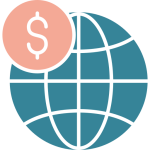Prices are rising. Interest rates are increasing. Brands across the fashion industry have less margin due to rising prices across most categories. Since the fashion industry has long buying and merchandizing cycles, fashion businesses that take action now to address these factors will be most successful in the short- and long term.
Consider consumer spending trends, regional inflation effects, and your business model when planning the 2023 strategy for your fashion business. We’ve identified six key actions you can take to optimize your approach.
What are consumer spending trends in 2023?

Overall, consumers are spending less and selecting more value-conscious options.
- Current Consumer Spending Trends
According to the most recent Consumer Pulse Survey, 37 percent of consumers plan to spend less on discretionary items. Seventy-four percent report trading down when they shop.
- Risks of Ignoring Current Consumer Spending Trends
Without a clear strategy to address the current economic climate, you could negatively affect your margins and performance for years to come. Here’s what to do to optimize your fashion business for success in 2023.
How is inflation affecting various markets worldwide?

Although inflation affects the world, regional factors often affect fashion brands. Your business will need to consider its regional exposures to develop the most effective strategy for 2023.
- Inflation in the United States
In an attempt to reduce inflation, the Federal Reserve continues to raise interest rates in the United States. Private sector wage increases in the US outpace those in other regions, which may indicate inflation will continue longer than in other areas.
- Inflation in Europe
In Europe, increasing energy prices significantly affect inflation. These effects may change quickly when the results of the war in Ukraine resolve. Fashion businesses with costs in US dollars and sales in euros will also need to consider the effects of currency fluctuation.
- Inflation in Asia
Although Asia is not experiencing inflation to the extent of other regions, economic growth is slow. Rising US interest rates and high commodity prices also affect the region’s financial health.
- Inflation in Latin America
Some Latin American countries are experiencing little inflationary risk. Others are implementing strong monetary responses to mitigate inflation’s effects.
How is inflation affecting the fashion industry?

Inflation affects various fashion businesses in different ways. Generally, fashion businesses affected most by disposable income are experiencing the most significant impacts.
- Effects on Luxury and Affordable Luxury Brands
Many luxury and affordable luxury brands remain relatively unaffected by current inflation. LVMH, which owns Christian Dior, Fendi, and Givenchy, reported 20% organic revenue growth in the first nine months of 2022.
- Effects on Premium Brands
Premium brands are affected by both inflation and consumer income. Value-conscious consumers select value, off-price and private label options instead of premium brands. Higher-income consumers generally continue selecting premium brands.
- Effects on Value Brands
There are several opportunities for value brands as consumers become more price-conscious. Consider offering more private-label products instead of brand-name. Meet shifting consumer demands by implementing an agile product design strategy.
- Effects on Discount Brands
Discount brands will likely see demand increase, especially from lower-income consumers. Consider purchasing low-cost inventory from retailers experiencing economic pressure.
6 Ways Fashion Brands Can Respond to Inflation and Current Economic Conditions

Although inflation is rising and consumer spending is falling, you can take steps now to position your fashion business for success.
Strategy 1: Maximize productivity in three key areas.
As prices rise, productivity becomes increasingly important. Make sure you examine these key areas:
● Review cost bases and supply and distribution networks. Look for opportunities to increase efficiencies.
● Reduce distribution overhead. Relocate distribution centers or use third-party logistics and supply-chain-as-a-service providers.
● Define key performance indicators (KPIs) that track customer behavior so that you can respond quickly to behavioral changes.
Strategy 2: Update your assessment and category strategy.
Consumers are increasingly value-conscious. For 67 percent of customers who tried a new brand, the value was the reason they switched. Be sure to consider the following to respond to consumer behavior effectively:
● Revise assortments and review entry-level price points.
● Increase private-label offerings.
● Use data to drive decision-making. Determine where customers are price-sensitive, and develop a response.
Strategy 3: Reprice strategically.
Sweeping price increases across all categories can decrease customer trust. Consider the following targeted approaches instead:
● Offer personalized promotions and loyalty incentives.
● Reprice by customer and product segment.
● Consider absorbing some higher costs in the short term.
Strategy 4: Review discounts and promotions.
Use data to guide decisions about pricing and promotion. Be sure to utilize data for the following:
● Manage inventory surplus and margins effectively.
● Analyze perceived value.
● Determine which attributes are valuable to consumers and make decisions accordingly.
Strategy 5: Upgrade your labor model.
Review your business model to find savings opportunities for labor costs are increasing. Ensure you examine the following:
● Labor allocation and scheduling
● Employee experience
● Recruitment and talent analysis
Strategy 6: Grow internationally without additional investment.
Many online stores focus on selling only to markets in the US and Canada. Take advantage of a worldwide market and increase growth by:
● Avoid hefty shipping fees and extended shipping times with BorderGuru’s low express shipping rates.
● Eliminate hassles at customs by seamlessly calculating and paying customs and duties seamlessly in real-time at the point of sale.
● Simplify customers’ shopping experiences and increase sales with simple checkout processes, no matter the customers’ locations.
Next Steps for the Fashion Industry in 2023
Current inflation and economic uncertainty affect the fashion industry. Fashion businesses that utilize short-term strategy, flexibility, and fast decision-making will be the most successful.
Ready to explore frictionless global logistics and expand your international reach? Book a call to learn more about BorderGuru and how you can convert your international traffic into loyal customers now


